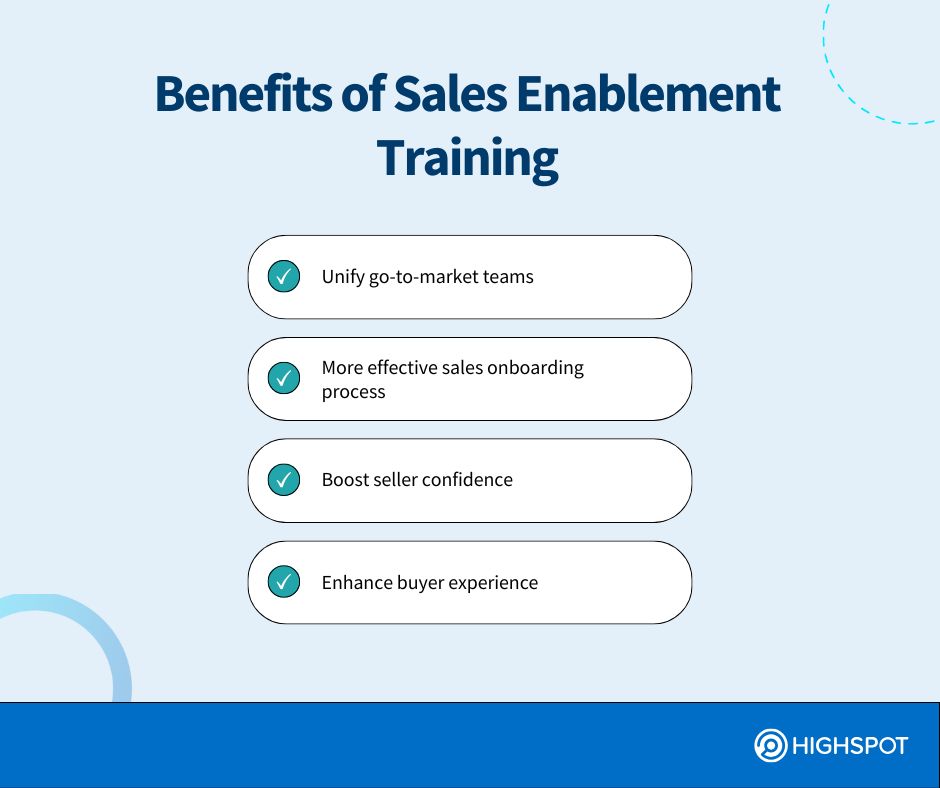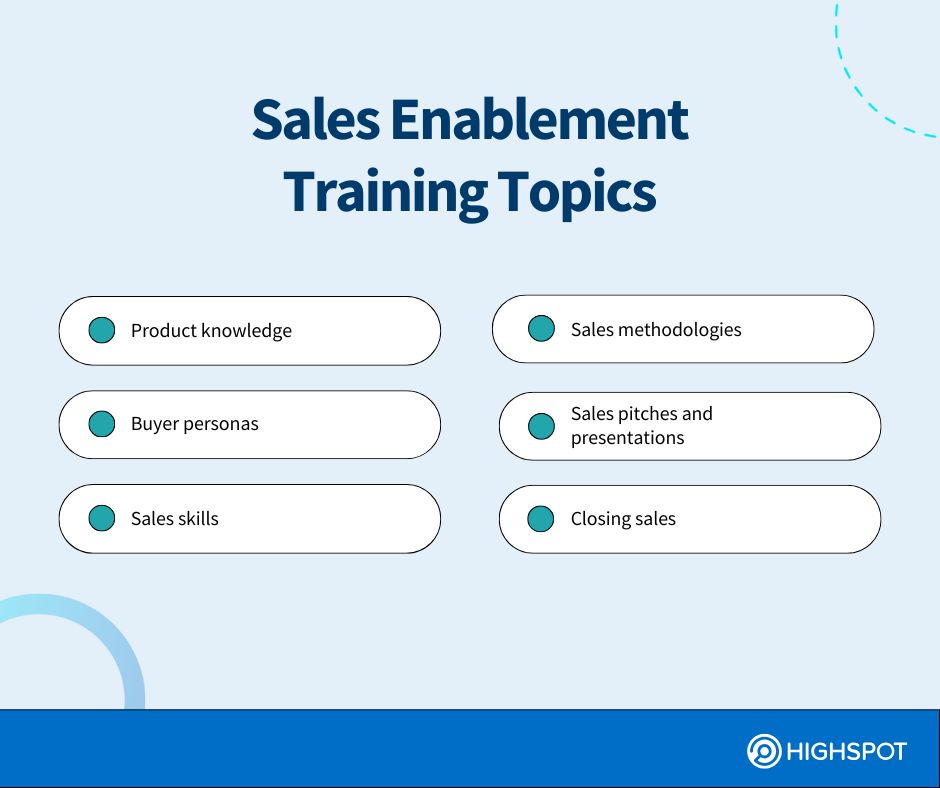Imagine having a sales team that hits or exceeds their targets without fail. It might sound like a lofty goal, but there’s a proven way to get there with sales enablement training.
54% of enablement teams that manage sales training programmes report a six-percentage-point increase in customer retention. Yet despite these benefits, many organisations still hesitate to implement and leave their teams underprepared, missing growth opportunities.
So, why the hesitation? It’s often too difficult due to a lack of clear goals, limited resources, and misalignment between sales, training, and marketing efforts.
If you’re ready to improve your sales organisation’s performance and buyer experience, this guide will show you how to create a sales enablement training programme that drives lasting results.
What is Sales Enablement Training?
Sales enablement training is a programme designed to empower sales teams with the skills, knowledge, and tools they need to perform at their best, close more deals, and reach their goals. This, in turn, supports your business in achieving its objectives and staying ahead of the curve.
It’s typically a cross-functional initiative between sales and marketing. The programme covers everything from onboarding and product knowledge to sales techniques and workflows.
What Does Sales Enablement Training Include?
Sales enablement training combines formal teaching and self-paced hands-on learning to equip sales reps with foundational knowledge and practical skills. Formal teaching covers essential topics such as sales strategies and customer insights, while self-paced modules allow learners to access resources like tutorials and quizzes at their convenience.
The training programme can also include personalised coaching to help sales reps refine their techniques and role-playing exercises to walk them through real-life sales scenarios. It usually includes sales enablement certification assessments to ensure reps meet performance standards before applying their training in the field.
What is the Difference Between Sales Enablement and Sales Training?
While sales training and enablement may seem interchangeable, they serve different purposes that are both crucial to the success of your sales strategy. At its core, sales training teaches sales reps how to sell, imparting essential skills and techniques for engaging customers.
On the flip side, sales enablement provides the tools to sell better. This encompasses access to content, information, and technology that sales reps can leverage to engage customers more effectively. It ensures they have the right resources, insights, and ongoing support to implement their skills and optimise their selling process after training.
Together, they create a powerful combination that can impact revenue growth. For instance, training teaches salespeople to pitch a product, ask better questions, or handle objections, while enablement ensures they can access customer data or case studies to support their pitch.
Benefits of Sales Enablement Training
With the right sales enablement training programme, even small changes can make a huge difference—from bringing teams together to boosting confidence and driving better outcomes.
Here’s how it can enhance your sales team’s performance:

1. Unify Go-to-Market (GTM) Teams
Sales enablement training eliminates silos between sales, marketing, product, and the rest of the go-to-market team because it aligns everyone around the same tools, messaging, and goals. On top of that, they can collaborate more effectively, share insights, and work towards a shared objective—driving revenue growth. This cohesion not only improves internal processes but also creates a seamless experience for the customer.
2. More Effective Sales Onboarding Process
A robust sales enablement training programme can significantly reduce the time it takes to onboard new sales reps. Instead of spending weeks trying to grasp company products, services, and sales strategies through trial and error, new reps can learn faster through structured training, real-time coaching, and readily available resources. Studies show that companies with solid enablement practices are 36% more likely to decrease ramp-up time through data-driven training, resulting in faster productivity.
Related Resource: What Good Onboarding, Training, and Coaching Looks Like
3. Boost Seller Confidence
Reps become more confident in their abilities by providing ongoing education, access to valuable resources, and opportunities for upskilling. This translates into better interactions with prospects and customers, as sellers can engage in meaningful conversations, handle objections effectively, and close deals with assurance. A confident sales team is not only more productive but also more resilient in the face of challenges.
4. Enhance Buyer Experience
Sales enablement clearly benefits sales team members, but it also enhances the buyer’s journey. When sales reps understand customer needs, respond with relevant solutions, and guide buyers through decision-making, they create a more personalised experience, helping them build better, more valuable relationships.
Now that we’ve covered the benefits of sales enablement training, you might be wondering how to start your programme.
How Do I Get Started with a Sales Enablement Training Programme?
Sales enablement training is not a one-time effort; it’s a long-term initiative that benefits sales representatives from their first day with your organisation. This training is valuable for both new and seasoned sales reps. It starts with a structure, goals, and needs identification.
Below are five steps to help you implement your own sales enablement training programme:
1. Establish a Structure and Charter
Over 60% of sales enablement functions lack a formal charter or annual planning process. Without a structured plan, enablement teams often find themselves in a reactive mode, fire-fighting urgent short-term tasks rather than focusing on more strategic long-term projects.
Ideally, enablement should be proactive in shaping the sales strategy rather than being called in only after decisions have been made. Before implementing a successful programme, you need to outline a clear structure. Who will deliver the training, and what resources will you need? Identify participants such as a training coordinator, sales managers, subject matter experts, and the learning and development team.
Additionally, outline the necessary curriculum resources, including training materials, a schedule, and feedback mechanisms, in the sales enablement charter. Defining this will ensure your programme runs smoothly from the start.
2. Determine What Your Sellers Need
To develop an effective sales enablement training programme, you must understand your team’s pain points, challenges, and knowledge gaps. Conduct surveys, interviews, or performance reviews to identify what tools, skills, and resources your sellers need to perform at their best. Additionally, there may be issues that aren’t easily communicated. For instance, you might discover that some reps struggle with objection handling by monitoring calls. You can then plan a workshop to review common objections and response strategies.
3. Identify Your KPIs and Goals
A sales enablement training programme must be driven by clear, measurable outcomes. To identify the right KPIs, review the areas where your sales efforts fall short and the struggles your sales reps face, then figure out the steps you need to take to reach your goal.
For instance, if your goal is to improve win rates by 30% by the end of Q2, a KPI could monitor the percentage of sales opportunities successfully converted into customers. In that case, the training should focus on identifying high-potential leads early on and equipping sales reps with the right sales pitches, demos, and presentations so that they can effectively communicate value.
Regularly assess sales enablement metrics and gather feedback from stakeholders. Evaluate quarterly to determine whether the training programme is making an impact, and don’t hesitate to adjust based on the data.
4. Understand How the Customer Journey Aligns With Your Sales Cycle
Map out each stage of the buyer’s journey and identify where sales reps can add value by addressing customer pain points. Once you see how it aligns with your sales process, you can tailor your sales enablement training and create a content library for specific stages, ensuring sellers can meet the customer with the right message at the right time.
If prospects are just learning about their problems and potential solutions, for example, offer educational content, like blog posts, whitepapers, and eBooks. The goal is to help prospects understand the challenges they face and their impact. Then, once they move through the funnel, provide sales collaterals that show how your product or service can help their business.
5. Evaluate and Adapt your Training Programme
Once your sales enablement training programme is in place, regularly assess its impact by analysing KPIs, gathering feedback from sellers, and tracking performance improvements. Are new reps ramping up faster? Is there a noticeable improvement in seller confidence?
Then, based on the data, adjust your training content, format, and delivery methods to address any gaps or areas for improvement. This ensures your enablement programme stays relevant, evolves with training trends, and continues the growth of your salesforce.
Sales Enablement Training Topics
Sales professionals require extensive knowledge to perform their roles. They need to understand your company structure and know whom to contact for information. They must also grasp product fundamentals, including the value, messaging, pricing, brand promises, and the competitive landscape.
While some of this knowledge comes with experience, not all reps have that luxury. Therefore, your sales enablement training must transfer this knowledge to sales reps from day one. A single one-hour onboarding session is insufficient. Instead, it would help if you had a structured initiative supporting sales reps throughout their careers within your organisation.
Below, we will explore the training course content that will help get your sales enablement programmes started:

Product Knowledge
Sales reps need to understand the products they are selling inside and out. This includes the features and benefits, as well as real-world use cases and success stories that illustrate their value. They should also have a good grasp of how the product stacks up against competitors.
Product training gives sales reps the confidence to answer tough questions and align solutions with customer needs. When they are well-versed in their products, they can communicate effectively with potential customers, making it easier to establish trust and credibility.
For example, if a software company launches a new analytics dashboard, teaching reps to share use cases—like how a client improved decision-making—helps them illustrate the product’s value. This approach equips reps to demonstrate precisely how the solution helps customers.
Buyer Personas
Teaching your team to work with different buyer personas is critical. This involves customer segments based on various factors, such as demographics, behaviours, needs, and challenges. Whether selling to a C-level executive or a mid-level manager, reps must understand the motivations behind their decisions and tailor their approach to create more meaningful connections.
Sales Skills
A sales enablement strategy must cover essential sales skills that help reps navigate the sales process and build rapport with clients.
- Handling objections: Teach reps to anticipate the most common objections, such as price, time, authority, and value, and confidently address these concerns with facts and data.
- Building customer relationships: Focus on fostering trust and connection with clients to strengthen long-term relationships.
- Understanding competition: Equip reps with competitive cheat sheets to differentiate your offering.
- Asking the right questions: Encourage curiosity by teaching reps to ask questions that uncover customer needs.
- Social media presence: Help reps leverage platforms like LinkedIn to engage prospects and build personal brands.
- Listening skills: Emphasise active listening to understand customer pain points and adjust solutions to unique needs.
- Identifying and prioritising leads: Train reps to recognise high-potential leads and focus their efforts.
Sales Methodologies
Sales leaders must determine which sales methodologies best suit the company’s goals, strategy, and customers’ needs. Whether you’re looking at solution selling or the Challenger sales model, these methodologies help provide a clear framework for your sales reps for different situations. Once you’ve picked the right approach, training your team on these methods is essential.
Sales Pitches and Presentations
The first impression a sales rep makes is crucial. Sales enablement training must focus on delivering a compelling pitch, whether over the phone or in person. Reps will also learn to structure presentations using storytelling techniques that resonate with various audiences. Provide playbooks, sales plays, and templates in your content library to streamline the preparation process and ensure consistent messaging and relevant information.
Closing Sales
Finally, teach your reps the art of closing sales. Sales enablement training should cover the various strategies for closing deals, such as understanding the buyer’s decision criteria, handling last-minute objections, and recognising buying signals. Sales reps should feel comfortable asking for a sale and creating a sense of urgency without being overly pushy. Effective closing strategies help ensure they win deals while maintaining a positive relationship with the customer.
Sales enablement training is essential for developing high-performing sales teams, but rolling out a structured programme can often seem overwhelming. This is where Highspot, a unified sales enablement platform, steps in to simplify the journey. It provides centralised access to resources, interactive learning experiences, and real-time analytics to transform how sales teams learn and grow. From delivering tailored playbooks to offering insights into sales performance, sales enablement becomes an ongoing, evolving process embedded into the daily workflow.
Request a Highspot demo today.




